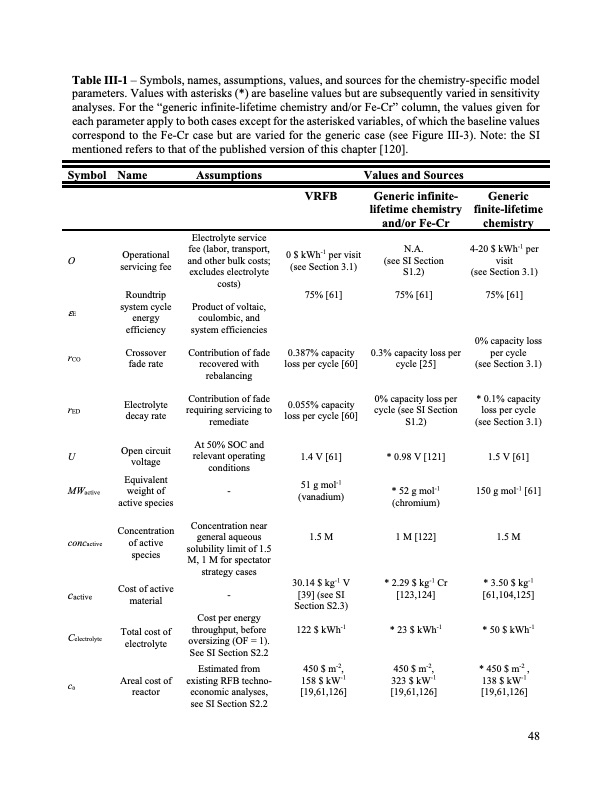
PDF Publication Title:
Text from PDF Page: 048
Table III-1 – Symbols, names, assumptions, values, and sources for the chemistry-specific model parameters. Values with asterisks (*) are baseline values but are subsequently varied in sensitivity analyses. For the “generic infinite-lifetime chemistry and/or Fe-Cr” column, the values given for each parameter apply to both cases except for the asterisked variables, of which the baseline values correspond to the Fe-Cr case but are varied for the generic case (see Figure III-3). Note: the SI mentioned refers to that of the published version of this chapter [120]. Symbol O εE rCO rED U MWactive concactive cactive Celectrolyte ca Name Operational servicing fee Roundtrip system cycle energy efficiency Crossover fade rate Electrolyte decay rate Open circuit voltage Equivalent weight of active species Concentration of active species Costofactive material Total cost of electrolyte Areal cost of reactor Assumptions Electrolyte service fee (labor, transport, and other bulk costs; excludes electrolyte costs) Product of voltaic, coulombic, and system efficiencies Contribution of fade recovered with rebalancing Contribution of fade requiring servicing to remediate At 50% SOC and relevant operating conditions - Concentration near general aqueous solubility limit of 1.5 M, 1 M for spectator strategy cases - Cost per energy throughput, before oversizing (OF = 1). See SI Section S2.2 Estimated from existing RFB techno- economic analyses, see SI Section S2.2 VRFB 0 $ kWh-1 per visit (see Section 3.1) 75% [61] 0.387% capacity loss per cycle [60] 0.055% capacity loss per cycle [60] 1.4 V [61] 51 g mol-1 (vanadium) 1.5 M 30.14$kg-1 V [39] (see SI Section S2.3) 122 $ kWh-1 450 $ m-2, 158 $ kW-1 [19,61,126] Values and Sources Generic infinite- lifetime chemistry and/or Fe-Cr N.A. (see SI Section S1.2) 75% [61] 0.3% capacity loss per cycle [25] 0% capacity loss per cycle (see SI Section S1.2) * 0.98 V [121] -1 * 52 g mol (chromium) 1 M [122] *2.29$kg-1 Cr [123,124] * 23 $ kWh-1 450 $ m-2, 323 $ kW-1 [19,61,126] Generic finite-lifetime chemistry 4-20 $ kWh-1 per visit (see Section 3.1) 75% [61] 0% capacity loss per cycle (see Section 3.1) * 0.1% capacity loss per cycle (see Section 3.1) 1.5 V [61] -1 150 g mol [61] 1.5 M *3.50$kg-1 [61,104,125] * 50 $ kWh-1 * 450 $ m-2 , 138 $ kW-1 [19,61,126] 48PDF Image | Bringing Redox Flow Batteries to the Grid

PDF Search Title:
Bringing Redox Flow Batteries to the GridOriginal File Name Searched:
Rodby-krodby-phd-chemE-2022-thesis.pdfDIY PDF Search: Google It | Yahoo | Bing
Salgenx Redox Flow Battery Technology: Salt water flow battery technology with low cost and great energy density that can be used for power storage and thermal storage. Let us de-risk your production using our license. Our aqueous flow battery is less cost than Tesla Megapack and available faster. Redox flow battery. No membrane needed like with Vanadium, or Bromine. Salgenx flow battery
| CONTACT TEL: 608-238-6001 Email: greg@salgenx.com | RSS | AMP |